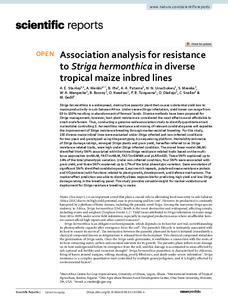| dc.contributor.author | Stanley, A.E. |
| dc.contributor.author | Menkir, A. |
| dc.contributor.author | Ifie, B.E. |
| dc.contributor.author | Agre, A.P. |
| dc.contributor.author | Unachukwu, N.N. |
| dc.contributor.author | Meseka, S.K. |
| dc.contributor.author | Mengesha Abera, W. |
| dc.contributor.author | Bossey, B. |
| dc.contributor.author | Kwadwo, O. |
| dc.contributor.author | Tongoona, P. |
| dc.contributor.author | Oladejo, O. |
| dc.contributor.author | Sneller, C. |
| dc.contributor.author | Gedil, M. |
| dc.date.accessioned | 2022-03-07T11:59:34Z |
| dc.date.available | 2022-03-07T11:59:34Z |
| dc.date.issued | 2021-12-17 |
| dc.identifier.citation | Stanley, A.E., Menkir, A., Ifie, B.E., Agre, A.P., Unachukwu, N.N., Meseka, S.K., ... & Gedil, M. (2021). Association analysis for resistance to Striga hermonthica in diverse tropical maize inbred lines. Scientific Reports, 11(1): 24193, 1-14. |
| dc.identifier.issn | 2045-2322 |
| dc.identifier.uri | https://hdl.handle.net/20.500.12478/7378 |
| dc.description.abstract | Striga hermonthica is a widespread, destructive parasitic plant that causes substantial yield loss to maize productivity in sub-Saharan Africa. Under severe Striga infestation, yield losses can range from 60 to 100% resulting in abandonment of farmers’ lands. Diverse methods have been proposed for Striga management; however, host plant resistance was considered the most effective and affordable to small-scale famers. Thus, conducting a genome-wide association study to identify quantitative trait nucleotides controlling S. hermonthica resistance and mining of relevant candidate genes will expedite the improvement of Striga resistance breeding through marker-assisted breeding. For this study, 150 diverse maize inbred lines were evaluated under Striga infested and non-infested conditions for two years and genotyped using the genotyping-by-sequencing platform. Heritability estimates of Striga damage ratings, emerged Striga plants and grain yield, hereafter referred to as Striga resistance-related traits, were high under Striga infested condition. The mixed linear model (MLM) identifed thirty SNPs associated with the three Striga resistance-related traits based on the multi-locus approaches (mrMLM, FASTmrMLM, FASTmrEMMA and pLARmEB). These SNPs explained up to 14% of the total phenotypic variation. Under non-infested condition, four SNPs were associated with grain yield, and these SNPs explained up to 17% of the total phenotypic variation. Gene annotation of significant SNPs identified candidate genes (Leucine-rich repeats, putative disease resistance protein and VQ proteins) with functions related to plant growth, development, and defense mechanisms. The marker-effect prediction was able to identify alleles responsible for predicting high yield and low Striga damage rating in the breeding panel. This study provides valuable insight for marker validation and deployment for Striga resistance breeding in maize. |
| dc.description.sponsorship | Deutscher Akademischer Austauschdienst (DAAD) |
| dc.description.sponsorship | Africa Centres of Excellence for Development Impact (ACE) |
| dc.description.sponsorship | Bill and Melinda Gates Foundation |
| dc.format.extent | 1-14 |
| dc.language.iso | en |
| dc.subject | Parasitic Plants |
| dc.subject | Drought |
| dc.subject | Yields |
| dc.subject | Farmers |
| dc.subject | Genes |
| dc.subject | Breeding |
| dc.subject | Genotypes |
| dc.subject | Maize |
| dc.subject | Striga Hermonthica |
| dc.subject | Plant Growth |
| dc.subject | Weeds |
| dc.title | Association analysis for resistance to Striga hermonthica in diverse tropical maize inbred lines |
| dc.type | Journal Article |
| cg.contributor.crp | Maize |
| cg.contributor.crp | Roots, Tubers and Bananas |
| cg.contributor.affiliation | International Institute of Tropical Agriculture |
| cg.contributor.affiliation | University of Ghana |
| cg.contributor.affiliation | University of KwaZulu-Natal |
| cg.contributor.affiliation | International Livestock Research Institute |
| cg.coverage.region | Africa |
| cg.coverage.region | West Africa |
| cg.coverage.country | Nigeria |
| cg.coverage.hub | Headquarters and Western Africa Hub |
| cg.researchtheme | Biotech and Plant Breeding |
| cg.identifier.bibtexciteid | STANLEY:2021 |
| cg.isijournal | ISI Journal |
| cg.authorship.types | CGIAR and developing country institute |
| cg.iitasubject | Agronomy |
| cg.iitasubject | Food Security |
| cg.iitasubject | Genetic Improvement |
| cg.iitasubject | Livelihoods |
| cg.iitasubject | Maize |
| cg.iitasubject | Pests of Plants |
| cg.iitasubject | Plant Breeding |
| cg.iitasubject | Plant Diseases |
| cg.iitasubject | Plant Genetic Resources |
| cg.iitasubject | Plant Production |
| cg.iitasubject | Smallholder Farmers |
| cg.iitasubject | Soil Fertility |
| cg.iitasubject | Weeds |
| cg.journal | Scientific Reports |
| cg.notes | Open Access Journal; Published online: 17 Dec 2021 |
| cg.accessibilitystatus | Open Access |
| cg.reviewstatus | Internal Review |
| cg.usagerightslicense | Creative Commons Attribution 4.0 (CC BY 0.0) |
| cg.targetaudience | Scientists |
| cg.identifier.doi | https://dx.doi.org/10.1038/s41598-021-03566-4 |
| cg.iitaauthor.identifier | 0000-0002-5907-9177 |
| cg.iitaauthor.identifier | 0000-0003-1231-2530 |
| cg.iitaauthor.identifier | 0000-0003-1004-2450 |
| cg.iitaauthor.identifier | 0000-0002-2239-7323 |
| cg.iitaauthor.identifier | 0000-0002-6258-6014 |
| cg.futureupdate.required | No |
| cg.identifier.issue | 24193 |
| cg.identifier.volume | 11 |

